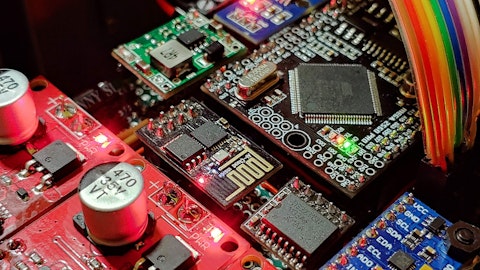Brett Cope: I mean, I — it’d be hard to say that that that more severe outcome isn’t on the thoughts and minds of certainly the owners as they’re trying to work their way through their project process in interacting with the government. I wouldn’t say that’s the case right now. I think everybody feels, at least early on here, that this is a slight slowdown and things will get back on track. It really doesn’t seem to be a lot of practical reasons and, if anything, it seems to be, again, not to be a political person here, but it certainly, from where I sit, hurts the States and a global outlook for what we’re trying to do around the world. So I got to believe that’s being echoed with folks with much bigger positions in this not than myself. And the interactions we’ve had with our clients and our engineering partners would seem to indicate that’s sort of the tenor at the moment.
John Braatz: Yes. Okay. All right. Okay. Thank you, Brett.
Brett Cope: Yes.
Operator: Next question is from John Deysher with Pinnacle. Please go ahead.
John Deysher : Good morning. Thanks for taking my question. On the LNG front, I realized that we’re not going to be canceling any existing projects or expansions, but can you give us an idea of in the backlog, how much of that backlog is LNG related at this point on a percentage basis roughly?
Brett Cope: Thinking back to, so we started at the end of 2022, sharing updates in the market. We never really quantified any one job. We really can’t, John, but it is, given the size and depth and breadth of what you’ve experienced with Powell over the years, it’s about 25%, 30%-ish, kind of in that range.
John Deysher: 25% to 30%, okay, is LNG related, that’s helpful. Okay, good. The other question is, you talked about the CapEx expansion of $11 million, I think, for one of the facilities. What is the CapEx budget for fiscal 2024 at this point?
Mike Metcalf: Yes, John, this is Mike. Typically, our normal burn rate in CapEx is roughly $4 million to $5 million. And as Brett mentioned, we are initiating an expansion at one of our facilities here in Houston, that is roughly $10 million or $11 million.
John Deysher: Yes.
Brett Cope: Little suspect that timing when that would actually report out, John, just because the permitting process, like always, is kind of like the other conversation we’ve had today. Whenever you get the government involved, you get a lot of help. So we’re working through that now. We’re excited by it and get the prospect of where we’re going with the things we’ve shared on the calls last two years about getting some new products out into the market and what the R&D team has been delivering for us.
John Deysher: Okay. When do you expect that $11 million expansion to start? And how long would it take to complete?
Brett Cope: Yes. We’ve started the process. We’ve got a prime contractor. I think in the next three to four months, we’ll probably go a little slower, just as we kind of get through all the permits and we’ll use that time to hone in all our final construction costs. So I think in earnest, sort of mid late summer. And once we get going, the build time isn’t too long, quite frankly. It’s a tilt wall building over there today at the factory and team came up with a really nice plan to go out the backside of the building and put in two really nice bays, adding the room we need for the future. So pretty excited to get going, but we’ll just have to get through that permitting process and then sometime mid fiscal next year, we ought to be up and going.
John Deysher: Okay. So it sounds like you won’t break ground until late summer and then probably a year or so to complete it.
Brett Cope: That’s correct. I mean, I hope we can move the permitting process and if that’s the case, we are absolutely ready to move quicker. We just have to get through the first three or four months.
John Deysher : Okay. Good. Fair enough. Thanks and good luck.
Brett Cope: Thanks, John.
Operator: The next question is a follow-up from John Franzreb with Sidoti & Company. Please go ahead.
John Franzreb: Yes, guys, I’m just curious a little bit about the tax rate. It’s a little bit lower than expected in the quarter. Anything going on there that we should be cognizant of?
Mike Metcalf: Yes. John, the lower effective tax rate relative to the U.S. statutory rate was driven by a one-time favorable tax item relative to stock-based compensation. So just to explain that a little further, as you know, our stock values appreciated considerably throughout 2023. And as such, the vesting price is significantly higher than the original grant price. That difference when they actually vested, generated a favorable tax benefit, reducing the ETR percent. So that was kind of a one-time item that was a benefit from a tax perspective in 1Q.
John Franzreb : So how should the tax number look on a go-forward basis, Mike?
Mike Metcalf: We are still targeting 24% ETR as we navigate through the remainder of the year.
John Franzreb: Great. And Brett, I’ve asked you this, I think, two quarters ago, and I’m going to revisit the question. What innings do you put the order booking rate at? Let’s revisit it now especially in light of how good the most recent quarter was at 198.


